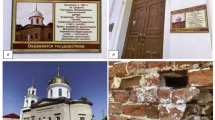Elemental analysis of more than 1000 y/o ceramic samples has shown that the primary chemical elements are (%): samples from the exterior part of the bricks — 24.45 Si; 14.31 Ca; 12.68 C; 11.55 Al; 5.60 Fe; 4.29 K; samples from the interior part of the bricks—32.23 Si; 17.66 Al; 12.66 Fe; 5.52 K; 3.07 C; 1.36 Ti; 1.34 C; inclusions in bricks — 53.11 Ñ; 13.40 Ca; 5.46 Si; 3.08 Al; 2.63 K; 1.78 Fe. X-ray phase analysis and electron microscopic methods of analysis showed that the strength properties of the ceramic samples are due to mullite, anorthite, and wollastonite. In addition, the presence of closed porosity in ceramic samples with pores of isometric and oval shapes increases longevity.



Similar content being viewed by others
References
V. Z. Abdrakhimov, “Effect of the phase composition on the durability of ceramic facing of the Shakhi-Zinda ensemble in Samarkand,” Steklo Keram., No. 3, 38 – 40 (2012); V. Z. Abdrakhimov, “Effect of the phase composition on the durability of ceramic facing of the Shakhi-Zinda ensemble in Samarkand,” Glass Ceram., 69(3–4), 104–106 (2012).
V. Z. Abdrakhimov and E. S. Abdrakhimova, “Interrelation of the phase composition and durability of more than 800 year old brick for the example of the Kazan Kremlin,” Steklo Keram., No. 2, 34–38 (2015); V. Z. Abdrakhimov and E. S. Abdrakhimova, “Interrelation of the phase composition and durability of more than 800 year old brick for the example of the Kazan Kremlin,” Glass Ceram., 72(1–2), 71–75 (2015).
V. Z. Abdrakhimov, “Relation between the phase composition and durability of ceramic brick older than 600 yr at the Ipat’evskii monastery,” Steklo Keram., No. 3, 29 – 32 (2013); V. Z. Abdrakhimov, “Relation between the phase composition and durability of ceramic brick older than 600 yr at the Ipat’evskii monastery,” Glass Ceram., 70(3 – 4), 100 – 103 (2013).
V. Z. Abdrakhimov and E. S. Abdrakhimova, “Phase composition of ceramic brick from the Kremlin in Astrakhan,” Steklo Keram., No. 3, 33 – 36 (2014); V. Z. Abdrakhimov and E. S. Abdrakhimova, “Phase composition of ceramic brick from the Kremlin in Astrakhan,” Glass Ceram., 71(3 – 4), 105 – 108 (2014).
E. S. Abdrakhimova and V. Z. Abdrakhimov, “Structural transformations of iron compounds in clayey materials according to Mossbauer spectroscopy,” Zh. Fiz. Khim., 80(7), 12 – 16 (2006).
V. F. Pavlov, Physical-Chemical Principles of the Firing of Building Ceramic Articles [in Russian], Stroiizdat, Moscow (1977).
V. F., Pavlov, I. V. Meshcherikov, and O. S. Grum-Grzhimailo, “Role of iron oxide in the formation of the structure of acid-resistant porcelain,” in: Proc. Scientific-Research Institute of Building Ceramic: Scientific Research on the Mechanization of Technological Processes and Development of New Compositions of Mixes and Glazes [in Russian], Moscow (1982), pp. 48 – 55.
G. I. Litvinova and V. P. Pirozhkova, Petrography of Nonmetallic Inclusions [in Russian], Metallurgiya, Moscow (1972).
S. Zh. Saibulatov, S. T. Suleimenov, and A. V. Ralko, Ash-Ceramic Wall Materials [in Russian], Nauka, Alma-Ata (1982).
V. P. Petrov, E. D. Belyankina, B. Z. Chistyakov, and V. V. Kozyrev, Wollastonite [in Russian], Nauka, Moscow (1982).
E. S. Abdrakhimova and V. Z. Abdrakhimov, “Use of wollastonite in the production of ceramic articles,” Materialovedenie, No. 10, 47 – 52 (2004).
V. F. Pavlov and V. S. Mitrokhin, “Formation of mullite during firing of clays and its association with the properties of articles,” Tr. NII Stroikeramika, Issue 32, 30 – 45 (1979).
V. F. Pavlov, V. F. Bystrikov, and N. I. Andreev, “Effect of Li2O, Na2O, and K2O additions on phase changes during the firing of clays of different mineralogical composition,” Steklo Keram., No. 2, 38 – 40 (1970); V. F. Pavlov, V. F. Bystrikov, and N. I. Andreev, “Effect of Li2O, Na2O, and K2O additions on phase changes during the firing of clays of different mineralogical composition,” Glass Ceram., 27(2), 112 – 114 (1970).
Author information
Authors and Affiliations
Additional information
Translated from Steklo i Keramika, No. 4, pp. 33 – 38, April, 2018.
Rights and permissions
About this article
Cite this article
Abdrakhimov, V.Z., Abdrakhimova, E.S. Chemical-Elemental, Phase Compositions and Porosity Structure of Ceramic Samples from Cham Tower (Vietnam) More Than 1000 Y/O. Glass Ceram 75, 154–159 (2018). https://doi.org/10.1007/s10717-018-0046-1
Published:
Issue Date:
DOI: https://doi.org/10.1007/s10717-018-0046-1




